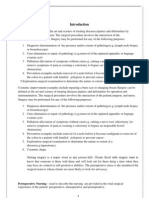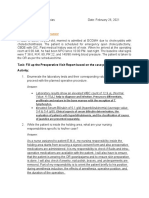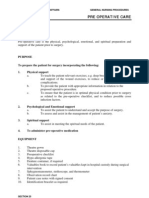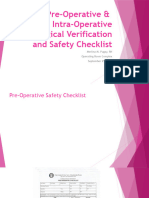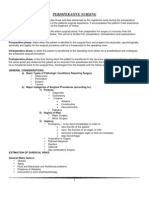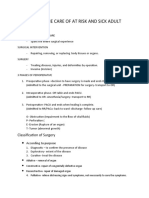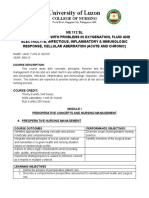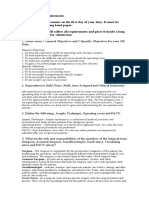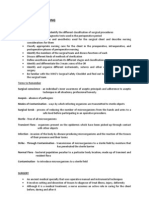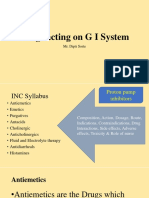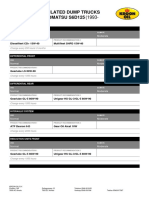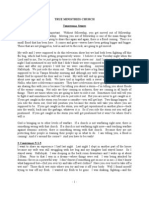Pre Op MNGMNT
Pre Op MNGMNT
Uploaded by
sandeepv08Copyright:
Available Formats
Pre Op MNGMNT
Pre Op MNGMNT
Uploaded by
sandeepv08Original Title
Copyright
Available Formats
Share this document
Did you find this document useful?
Is this content inappropriate?
Copyright:
Available Formats
Pre Op MNGMNT
Pre Op MNGMNT
Uploaded by
sandeepv08Copyright:
Available Formats
TAKING CARE OF THE PRE-OPERATIVE AND POST-OPERATIVE CLIENT
INTRODUCTION
Taking care of a client who is going to have surgery or who recently had
surgery can be two of the most important responsibilities you will have as a
Certified Nursing Assistant (CNA). Even for relatively young and healthy
individuals, surgery is a psychologically and physically stressful experience and
the stress does not end after the operation is completed. Surgery may be a cure
for an illness, but being cured is not the end of the story. In the hours and days
after a surgical procedure, clients are often in pain and they often feel weak, and
nauseous, and the recovery period can be prolonged. There are also many
possible complications that can happen after surgery. These can delay the
client's recovery and they can be dangerous. If the client is elderly or has many
medical problems, both the operation and the post-operative period can be risky.
Surgery, unless it is a very minor procedure, is serious proposition that is
associated with complications and risks.
STATEMENT OF PURPOSE
This module will provide CNAs with the information they need to provide
comprehensive pre-operative and post-operative care.
cnaZone.com cnaZone.com cnaZone.com cnaZone.com cnaZone.com cnaZone.com 1
TAKING CARE OF THE PATIENT BEFORE SURGERY
The period of time before a surgical procedure is called the pre-operative
period, and the period of time after surgery is called the post-operative period.
Patients must be prepared for both because surgery and the hours and days
after an operation can be very stressful. Good preparation before surgery will
make the post-operative period more comfortable for the patients and it will help
post-operative complications.
Preparing a patient for surgery in the pre-operative period should focus on
these areas: pre-operative tasks and education, and psychological preparation
and support.
PREOPERATIVE TASKS AND EDUCATION
Surgery and the post-operative period typically receive a lot of attention, but
the pre-operative period is very important as well. Preparing a patient for surgery
will help the patient recover physically and psychologically and prevent post-
operative complications, and many of the pre-operative tasks are essential for
physical recovery and preventing post-operative complications.
Informed Consent
One of the basic rights of all patients is the right to accept or refuse medical
and surgical treatment. Surgery, invasive procedures, or any medical or surgical
treatment that is not considered to be routine can only be performed if a
healthcare professional - in this case a surgeon and/or anesthesiologist - has
obtained the patient’s consent. Patient consent is not typically required if a
cnaZone.com cnaZone.com cnaZone.com cnaZone.com cnaZone.com cnaZone.com 2
procedure is considered to be routine, eg, a venipuncture for obtaining a blood
sample.
Of course, simply obtaining consent is not sufficient. It would not be enough for
a surgeon to ask permission to remove a gall bladder and for the patient to
agree. The consent to perform surgery or an invasive procedure must be
accompanied by information. It must be informed consent.
Informed consent indicates that prior to surgery the patient has been informed
by the surgeon, and the patient understands, the following:
1) His/her diagnosis
2) The nature of the surgery/procedure.
3) Why the surgery/procedure is being done.
4) The risks and benefits of the surgery/procedure.
5) The risks and benefits of not having the surgery/procedure performed.
6) What outcome she/he can expect.
7) What the post-operative period and the recovery period will be like.
8) Alternatives to the surgery/procedure and their risks and benefits.
All of this should be discussed with the patient and the patient will then sign a
surgical consent form. The surgical consent form is basically an agreement that
is signed by the physician and the patient or by the patient and a witness. The
surgical consent form indicates that the information outlined in the numbered list
above has been discussed with the patient and that the patient understands what
was discussed.
cnaZone.com cnaZone.com cnaZone.com cnaZone.com cnaZone.com cnaZone.com 3
Learning Break: If the patient is unable to understand the risks and benefits of a
surgery or procedure and there is an immediate danger to life and health a
consent form or a surgical consent form is not needed. Children, minors, and
people who are intellectually or psychologically incapable of understanding the
risks and benefits of a surgery or procedure cannot sign an informed
consent/surgical consent form because they are incapable of being informed.
The surgical consent form is signed by the patient. Sometimes the surgeon will
sign the form, but many times a nurse will sign the form after she/he has
witnessed the patient signing it. When someone signs a surgical consent form or
an informed consent form as a witness that simply indicates that that person has
correctly identified the patient and he/she witnessed the patient signing the form.
It does not mean that the witness explained the procedure, the risks and benefits,
etc. That information is documented in the patient’s chart by the physician. The
witness is only agreeing that he/she saw the patient signing the form, and the
patient signing indicates that he/she has been informed.
This concept is a bit difficult to understand and the issue could be avoided by
having the physician witness the signing after informing the patient, but in many
busy health care facilities this does not happen. The important issue is not the
signing or the witnessing; the important issue is the patient being informed and
that is the responsibility of the physician.
Learning Break: What should you do if you are asked to witness an informed
consent form? This situation is extremely unlikely to happen but if it does it would
be sensible for you to decline or discuss the situation with your supervisor.
cnaZone.com cnaZone.com cnaZone.com cnaZone.com cnaZone.com cnaZone.com 4
Pre-Operative Checklist
The pre-operative check list is the final document that must be completed
before the patient is transferred to the operating room. It indicates that all the
necessary preparations for surgery have been completed, and this document
must accompany the patient when he/he leaves for surgery. Figure 1 provides an
example of a typical pre-operative checklist. Most of these items are standard for
a pre-operative checklist but the form can be varied to meet the patient’s needs.
For example, some patients will need to have bowel preparation prior to surgery
and if so, this should be documented in the chart and on the pre-operative
checklist.
Figure 1: Pre-Operative Checklist
Patient name
Date of birth
Positive identification of the patient by two witnesses
Verification of an identity band that correctly identifies the patient
Name of the surgery
Vital signs
Last time of voiding
Contact lenses, dentures, and hearing aids removed (if applicable)
Jewelry removed
Drug allergies
Pre-operative medications, eg, names, doses, times administered
Verification that the patient has been NPO for the length of time ordered by the
physician
Laboratory test results
X-ray test results
ECG
Completion of the pre-operative checklist is the responsibility of a nurse, nurse
practitioner, or physician’s assistant. That person examines the patient and
reviews the chart to make sure that all of the required information is in the chart
and all of the required tasks (eg, vitals signs taken and recorded) have been
cnaZone.com cnaZone.com cnaZone.com cnaZone.com cnaZone.com cnaZone.com 5
done. However, if you are caring for a patient who will be having surgery you
should make sure that the pre-operative checklist is on the chart and it has been
completed. The day of a surgery can be hectic and rushed and mistakes are
possible.
NPO Before Surgery
The letters NPO are abbreviation for a Latin phrase, nil per os - nothing by
mouth. This is an important pre-operative concept and will be discussed here in
detail.
Patients who will be having surgery are required to refrain from eating or
drinking for a specified period of time before the operation surgery, unless the
surgery is very minor and/or only a local anesthesia will be used. General
anesthesia can cause vomiting, and vomiting during surgery or in the first few
hours after surgery can cause aspiration of stomach contents into the lungs. This
can be a serious operative or post-operative complication and it is easily avoided
by keeping the patient NPO.
The traditional phrase applied to these situations was NPO after midnight.
That may still be true in some cases, but the hour at which NPO begins is not as
important as the amount of time the patient is NPO before the surgery. In most
cases surgeons and anesthesiologists prefer that the patient has no solid food for
eight hours before an operation and no liquid for four hours but these time limits
vary on a case by case basis. In addition, these restrictions can be relaxed if
needed. For example, someone who takes an anti-hypertensive and a
cnaZone.com cnaZone.com cnaZone.com cnaZone.com cnaZone.com cnaZone.com 6
hypoglycemic drug for control of diabetes may be allowed to take her/his
medications an hour or two before surgery if they only use a small sip if water
Learning Break: Although there can be exceptions, it is much safer to keep a
patient NPO unless you have been specifically told by a nurse, PA, or MD that it
is acceptable for a pre-operative patient to have something by mouth. If in doubt,
keep the patient NPO.
Skin Preparation
An intact skin is the body’s first line of defense against infection. However,
surgery involves breaking that line of defense with an incision. In addition, the
surface of the skin is home to countless numbers of bacteria, the so-called
normal flora of the skin, and these bacteria are the source of most surgical
wound infections. So although surgery involves sterile technique, even the most
conscientious use of sterile technique cannot prevent all surgical wound
infections. Because of these risk factors, preparation of the skin by a thorough
cleaning before surgery is often performed to decrease the risk of infection and it
is a vital part of the pre-operative procedure
There are far too many pre-operative skin preparation techniques to discuss
them here in detail. However, the basic procedure involves cleaning the skin on
and around the surgical area and removing hair from the area that will be incised
during surgery. Cleaning the surgical area is done so that the incision will not
become infected and hair is removed because it can interfere with procedure. In
addition body hair harbors bacteria and that bacteria cannot be removed if the
hair is not removed. Removing body hair and removing it by shaving was once
cnaZone.com cnaZone.com cnaZone.com cnaZone.com cnaZone.com cnaZone.com 7
standard procedure. Now, for many procedures body hair is not removed and if it
is removed, clippers or a depilatory cream are the preferred methods. The
depilatory creams can also be used for areas that are difficult to shave. Shaving
can damage the skin by creating small cuts and this increases the chances that
an infection will develop.
The surgeon will write orders that will specify what part of the body is to be
cleaned, how it should be cleaned, what should be used, and when and where it
should be done. Do not clean any other area and only use the method(s) that
have been ordered.
Learning Break: The definition of the term sterile is “the absence of all living
microorganisms.” This would be the optimum condition of a surgical site but it is
not possible. Sterilizing skin would require extremely harsh chemicals or the
application of intense heat that would cause burns. Sterile technique should be
used when preparing the skin for surgery, but skin cannot be made sterile it can
only be cleaned.
Pre-Operative Teaching
Pre-operative teaching prepares the patient for all parts of surgery, and it can
speed recovery and help prevent complications. The most important areas to
cover in pre-operative teaching are the 1) surgical procedure; 2) the operative
day; 3) the post-operative period, and; 4) post-operative exercises. Post-
operative exercises will be discussed in a separate section.
1) The surgical procedure: The patient should know what type of operation is
being performed and why it is being done. The first person to give this
cnaZone.com cnaZone.com cnaZone.com cnaZone.com cnaZone.com cnaZone.com 8
information and the primary source for this information should be the
surgeon. However, as a CNA you should know what type of surgery is
being done and why, so you can provide the patients with some basic
information if he/she has questions. Ask your immediate supervisor what
is permissible for you to discuss with the patients. If a patient asks you
about the operation and it seems as if she/he needs more education or
has questions you should not address, tell your immediate supervisor;
he/she will notify the surgeon. Do not discuss details such as the risks of
the procedure, how the procedure is done, or how long before the patient
can go home.
2) Operative day: The patient should be educated about what will happen the
day of the surgery. Check the chart to see what has been ordered. An IV
line will often be inserted and the patient may be given some medication
that will prepare them for the operation: these medications frequently
cause drowsiness and may even put the patient to sleep. The informed
consent form should be signed and on the chart. The pre-operative
checklist should be completed, and you will be asked to help with some of
the items on the checklist, eg, checking vitals signs, making sure the
patient is wearing an identification band, and helping the patient remove
dentures or contact lenses.
3) Post-operative period: The client also should be informed about what to
expect during the post-operative period. Check the chart to see what has
been ordered. Each case is different, but it is very common for patients to
cnaZone.com cnaZone.com cnaZone.com cnaZone.com cnaZone.com cnaZone.com 9
feel drowsy, nauseated, and in pain after the operation and they should be
informed of this. Patients will want to know how long the drowsiness, pain,
and nausea will last. They will want to know when they can get out of bed,
when they can have food and water, how long they will be in the hospital,
and when they can go home. They may ask you if the operation was
successful. After speaking with your supervisor and checking the post-
operative orders on the chart, you can give the patient some basic
information. However, use common sense. Do not offer any information
beyond these basics or beyond what your supervisor has approved.
Post-Operative Exercises
Post-operative exercises can help prevent post-operative complications and
they can also speed the recovery process. Teaching post-operative exercises
before surgery gives the patient a stress-free and pain-free time to practice these
exercises. It also gives the healthcare professionals time to reinforce to the
patient how important post-operative exercises can be. Commonly used post-
operative exercises are discussed. If the patient has a history of lung disease or
is a long-time smoker it is especially important to review and practice coughing
and deep breathing because these patients are susceptible to post-operative
pulmonary complications.
1. Coughing: Patients are lying completely immobile during surgery and in
many cases they have been they have been on bed rest before the
operation. Because the client has not been moving for a long time,
secretions can pool in the lungs, bacteria can grow and a pulmonary
cnaZone.com cnaZone.com cnaZone.com cnaZone.com cnaZone.com cnaZone.com 10
infection can happen. For example, if the surgery lasts between 2-3 hours
the patient is 5 times as likely to develop post-operative lung
complications. In addition, patients who have had abdominal or chest
surgery will be less likely to cough normal as a forceful cough can be quite
painful to a surgical incision in those areas. Coughing exercises are a very
effective way to prevent post-operative lung infections. Coughing will help
expand the lungs and bring up secretions, and coughing exercises are
simple to teach and easy to do. The patient should be sitting upright and it
is recommended that a towel or a small pillow be held firmly over the
surgical incision; this can be done by a CNA or by the patient. Instruct the
patient to take a deep breath, hold the breath for a second or two and then
give a forceful cough. Cough from the belly, not the throat. Press down on
the towel that is covering the incision during the cough. This is called
splinting. It will stabilize the area, help prevent pain, and allow the patient
to perform the exercises. Repeat the procedure several times. A typical
plan will be to have the patient perform 5-10 cough and 5-10 deep breaths
every two hours, but the specifics of the routine will be ordered by the
physician. Let the patient know that he/she will be asked to do coughing
after the surgery and explain why the exercise is important. Also inform
them that coughing exercises can be painful but that the pain can be
controlled.
2. Deep breathing: Deep breathing can be performed by itself but it is usually
done along with the coughing exercise and like coughing, it expands the
cnaZone.com cnaZone.com cnaZone.com cnaZone.com cnaZone.com cnaZone.com 11
lungs and prevents lung infections. Instruct the patient to take a very deep
breath, hold the breath for a second or two and then slowly exhale.
Splinting may be helpful and in many cases it will be necessary in order
for the patient to perform deep breathing. As with the coughing exercise,
tell the patient that he/she will probably be asked to do deep breathing
exercises after surgery and explain why the exercise is important. Deep
breathing exercises can also be done using an incentive spirometer. An
incentive spirometer is a plastic tube with an attached flexible hose and a
mouthpiece at the end of the hose. The tube has gradations and a plastic
ball inside the tube. To use the incentive spirometer the patient inhales as
deeply as possible, places the mouthpiece in his/her mouth and then
exhales through the flexible tube. As the patient exhales the movement of
air will cause the plastic ball inside the incentive spirometer tube to rise,
and the level of the ball is compared to the gradations. Deep breathing
exercises using an incentive spirometer provides patients and those
caring for them with an objective way of measuring how well a patient is
performing deep breathing exercises. An illustration of an incentive
spirometer is provided in Figure 2.
cnaZone.com cnaZone.com cnaZone.com cnaZone.com cnaZone.com cnaZone.com 12
Figure 2:
Incentive Spirometer
3. Turning: Patients will benefit from being turned from side to side every two
hours after surgery. If possible the patient should turn by herself/himself
but some patients will need assistance. Turning from side to side prevents
skin damage, increases circulation, and prevents secretions from pooling
in the lungs and causing an infection. Moving after an operation can be
painful so take your time and don't rush the patient. As with coughing and
deep breathing, splinting while turning may be helpful and at times it will
be necessary.
4. Walking: Early ambulation after surgery is frequently recommended as a
method for preventing post-operative complication, specifically pulmonary
complications and peripheral blood clots. Patients certainly do not need to
be taught how to walk. But they should be informed that the surgeon may
cnaZone.com cnaZone.com cnaZone.com cnaZone.com cnaZone.com cnaZone.com 13
recommend early ambulation and that this will probably be painful to do.
Preparing the patient for this is far preferable to surprising someone, and if
the patient understands the need for this exercise before the surgery it can
help her/him comply.
5. Exercises: Patients who have had orthopedic surgery are typically
required to perform specific exercises during the post-operative period.
Example: Someone who has had a total knee replacement will be asked
to do straight legs raises, supported knee bends, and quadriceps
tightening, and these will often be started a few hours after the surgery.
Psychological Preparation and Support
Surgery is a stressful experience and it can be frightening. The patient is often
having surgery because he/she has a serious illness. Surgery involves risks,
complications, and pain and discomfort before and after the operation. There is
the possibility that the patient's life will be drastically changed, and not all
surgeries are completed successfully.
So, psychological preparation and support are important in the pre-operative
period. It is impossible to make a general statement about the best way to
psychologically prepare someone for surgery and how to provide that person
support. However, there are several things to consider:
What does the patient want to know? Some patients will want a lot of
detailed information about the operation, the pre-operative period, the
recovery period, and what life will be like after the surgery. Some patients
want to know very little, and they feel most comfortable when all the
cnaZone.com cnaZone.com cnaZone.com cnaZone.com cnaZone.com cnaZone.com 14
decisions are made for them. There is no right or wrong way: the patient
must make the decision.
What does the patient need to know? It is up to each person to decide
how much they know about their surgery. However, even for people who
prefer to know almost nothing they should be informed about what type of
surgery they are having, when it is being done, and why. Remember, the
surgeon is the first source of these facts, but if the surgeon has told the
patient this information you can review it with the patient as needed.
What are the patient's fears? Fear is a normal feeling associated with
surgery. Patients should be allowed to talk about their fears to the extent
that they want to. The best approach is simply to let the patient know that
there are people who will listen and can provide support if they want to
talk. After that, the patient can decide who he/she wants to confide in and
what they want to express.
TAKING CARE OF THE PATIENT AFTER SURGERY: POST-OPERATIVE
CARE AND POST-OPERATIVE COMPLICATIONS
Post-operative care is just as important as pre-operative care. The patient has
just been through a very stressful experience, serious complications are possible,
and pain, vomiting, and discomfort are common. Knowing what to look for and
what to do for a post-operative patient client is crucial. In order to provide good
post-operative care you must focus on the following areas.
cnaZone.com cnaZone.com cnaZone.com cnaZone.com cnaZone.com cnaZone.com 15
Table 1: Post-Operative Care: Areas of Concern
Vitals signs
Mental status
Pain
Surgical dressing
Bleeding
Urinary retention
Nausea and vomiting
Infection
Vital Signs
The surgeon, anesthesiologist, physician’s assistant, or nurse practitioner will
write an order that specifies how often the vital signs should be checked.
Measuring the pulse and blood pressure every 15 minutes in the first hour after
the operation is not unusual. You should always let someone know about a fever
or an abnormal pulse or blood pressure, but it is especially important when caring
for a post-operative client. Slight deviations of pulse and blood pressure may be
normal after surgery, but these should still be reported. Do not assume that a
pulse > 100 or a systolic blood pressure that is low are of no concern.
Mental Status
Drowsiness is expected after surgery. This can be minimal or it may be
significant. However, excessive drowsiness or drowsiness that is not improving is
not normal and a nurse or physician should be informed if you feel that that the
patient’s mental status is abnormal.
Pain
cnaZone.com cnaZone.com cnaZone.com cnaZone.com cnaZone.com cnaZone.com 16
Pain is inevitable following surgery. An incision has been made through the
skin and the swelling and bleeding at the incision increase pressure on nerve
endings, contributing to the pain.
Some patients will tell you about their pain and request medications but others
will not. You should always ask the post-operative patient if she/he is having
pain, but you should also be observant. A patient may decide to “work through
the pain” or the patient may be wary of accepting pain medications. So aside
from asking the patient about pain you should look for objective information and
non-verbal cues that indicate the presence of pain. Does the patient grimace
when asked to move? Is the patient hesitant about performing coughing and
deep breathing exercises? Is his/her blood pressure and heart rate elevated?
Pain control is important as it increases the speed of recovery, and it is important
for its own sake.
The level of pain a patient has will depend in part on what operation was
performed. The pain associated with a minor procedure should be mild but if the
patient has had a major orthopedic surgery such as hip surgery the pain can be
severe. There is no “normal” level of pain and each person has a level of
tolerance. But if the procedure was as simple one and the patient is significantly
uncomfortable, this may indicate a problem and a nurse or physician should be
informed. Also, if the patient is requesting pain medication more frequently than it
has been prescribed, this is a warning sign.
Learning Break: Many health care facilities use pain scales to assess patients’
level of pain. A typical pain scale is the 1-10 scale. The patient is asked to
cnaZone.com cnaZone.com cnaZone.com cnaZone.com cnaZone.com cnaZone.com 17
remember the worst pain she/he ever experienced and consider that a 10. The
patient is then asked to remember a painful experience that was very minor and
consider that a 1. After that the patient is asked to assign his/her current level of
pain a number on the 1-10 scale. Example: “If the worst pain you have ever had
was a 10 and a very minor pain you’ve experienced was a 1, what would you
consider your current level of pain to be?”
Surgical Dressing
A surgical dressing is a sterile cover applied over the incision. A dressing can
be a small bandage, but it may be a large, complicated affair with gauze pads
and tape. The surgeon will write orders that specify how to care for the dressing.
It is very important to follow these orders exactly. Do not change or adjust the
dressing in any way that has not been ordered. Check the dressing frequently to
make sure it is intact and there are no loose edges. Look for bleeding or unusual
drainage and if you notice either one inform a nurse or physician.
Bleeding
A slight amount of bleeding can be expected at the surgical incision site. In
most cases the bleeding will be under the dressing and will not be seen until it
has been changed. Bleeding that stains through the dressing is much less
common and should be reported.
Urinary Retention
Urinary retention is defined as a failure to void and a documented bladder
volume of > 600 mL. Urinary retention is a common postoperative problem and
depending on the nature of the surgery it can affect up to 25% of all patients.
cnaZone.com cnaZone.com cnaZone.com cnaZone.com cnaZone.com cnaZone.com 18
Anesthesia and analgesics can cause urinary retention, and pain, anxiety, and
trying to void while in a supine position can contribute to the problem. Urinary
retention can result in a prolonged hospital stay, bladder infections, an iatrogenic
infection from urinary catheterization, and bladder dysfunction.
The last time the patient voided should be documented on the chart. The
surgeon or the anesthesiologist may indicate when he/she expects the patient to
void. If voiding has not occurred by that time or if the patient is uncomfortable a
nurse or a physician should be notified. An ultrasound will be performed to
determine the volume of urine in the bladder and if urinary retention is present, a
urinary catheter can be inserted.
Nausea, Vomiting, and Constipation.
Nausea and vomiting are very common post-operative problems. In the great
majority of cases they are mild and temporary and can be easily treated with an
anti-emetic such as Zofran (ondansetron). If the nausea and vomiting persist
and/or are causing the patient pain a nurse or a physician should be notified.
Constipation is another common gastrointestinal post-operative complication.
Notify a nurse or physician is the patient is having difficulty having a bowel
movement.
Infection
Despite the careful use of sterile technique, post-operative infections cannot
be eliminated. There will always be patients who develop a post-operative
infection and for some patients the risk is high. Examples are provided below.
People who have diabetes have poor circulation.
cnaZone.com cnaZone.com cnaZone.com cnaZone.com cnaZone.com cnaZone.com 19
Long-time smokers or people who have lung disease are susceptible to
post-operative pulmonary complications.
Elderly patients do not tolerate anesthesia as well as younger patients,
putting them at risk for post-operative complications.
Even if the surgical site was carefully prepared and the surgical procedure
was performed meticulously, an incision through the skin exposes the
internal environment to microorganisms.
Regardless of age or health status, every patient who undergoes surgery
is at risk for post-operative infections. The patient has been immobile so
secretions in the lungs begin to pool and bacteria can multiply. The
bladder is not emptied and bacteria can grow in the urine. Blood stagnates
and may become infected in the extremities, and intact skin is disrupted by
the surgical incision.
Post-operative infections can happen in the lungs, the surgical incision, and
the bladder, and blood pooling in the legs can cause blood clots to form which
can become inflamed and occasionally, infected. A simple way to remember
these areas of concern is to use the four Ws of post-operative infections and
complications: wind, wound, water, and walk. Wind is associated with pulmonary
complications; wound is associated with surgical incision complications; water is
associated with bladder complications, and; walk is associated with lower
extremity complications.
Signs and symptoms of post-operative infection are listed in Table 2.
cnaZone.com cnaZone.com cnaZone.com cnaZone.com cnaZone.com cnaZone.com 20
Table 2: Signs and Symptoms of Post-Operative Infection
Confusion
Dyspnea
Dysuria
Fever
Hypertension
Hypotension
Pain
Peripheral edema
Productive cough
Purulent drainage at the incision site
Redness at the incision site
Tachycardia
Tachypnea
If the patient is young and healthy and the surgery is a routine procedure the
post-operative period will be uneventful. The patient may experience some
nausea and vomiting and mild pain but no serious complications will occur. If the
patient has certain risk factors and/or undergoes a major procedure the post-
operative period may be more difficult and these patients will need careful
monitoring.
Table 3: Risk Factors for a Complicated Post-Operative Period
Advanced age
Alcohol abuse
Chronic obstructive pulmonary disease (COPD)
Cigarette smoking
Diabetes
Dementia
Heart disease
Immunosuppression
Liver disease
Obesity
Sedentary life style
cnaZone.com cnaZone.com cnaZone.com cnaZone.com cnaZone.com cnaZone.com 21
SIGNIFICANT POST-OPERATIVE COMPLICATIONS
The following situations that can occur in the post-operative period are
emergencies or may indicate something is seriously wrong. If any of them occur
notify someone immediately.
1) Dehisence: When a surgical incision splits open, that is called dehisence
and dehiscence is an emergency. Do no insert anything into the incision
site and do not touch the area. Call for help immediately and if possible,
put on sterile gloves and cover the incision site wound with a moist, sterile
dressing.
2) Prolonged vomiting: Prolonged vomiting can increase intracranial
pressure, it can be dangerous for someone who has cardiac disease, and
it can affect the integrity of the surgical incision site. There is no clear-cut
definition of prolonged vomiting, but if the vomiting is causing pain,
prevents oral hydration, or is not relieved with an anti-emetic then it can be
considered prolonged.
3) Bleeding at the surgical incision: A slight bit of blood oozing or a small
stain on the surgical dressing is not serious. However, anything more than
that should be considered potentially serious and may indicate bleeding
below the surgical incision where it can’t be seen.
4) Severe pain: Pain that is causing significant changes in vital signs or is
causing the patient requires the immediate attention of a physician.
5) Abnormal changes in the client's vital signs or mental status.
cnaZone.com cnaZone.com cnaZone.com cnaZone.com cnaZone.com cnaZone.com 22
You might also like
- Peri - Operative Nursing: Learning Manual DescriptionDocument41 pagesPeri - Operative Nursing: Learning Manual DescriptionCezanne Cruz100% (5)
- CH 5 Differentiation Multiple Choice Questions (With Answers)Document7 pagesCH 5 Differentiation Multiple Choice Questions (With Answers)CRPF School80% (44)
- Session 1Document5 pagesSession 1Sistine Rose Labajo100% (2)
- Pre and Post Op Care: by Elaine Jones + Anne WrightDocument29 pagesPre and Post Op Care: by Elaine Jones + Anne WrightSarah Eddiah100% (3)
- JCI PresentationDocument66 pagesJCI PresentationOsama MarzoukNo ratings yet
- Preoperative and Postoperative Care SeminarDocument50 pagesPreoperative and Postoperative Care SeminarRenuka Sivaram88% (8)
- Module 1 Case StudyDocument7 pagesModule 1 Case StudyDivine ParagasNo ratings yet
- Preoperative AssessmentDocument24 pagesPreoperative AssessmentjahangirealamNo ratings yet
- Swatilekha Das (RN, MSN)Document20 pagesSwatilekha Das (RN, MSN)sandeepv08No ratings yet
- Lecture 2Document9 pagesLecture 2omarelbihi8No ratings yet
- MODULE VIII-workflowDocument17 pagesMODULE VIII-workflowjanriomanzanoazumaNo ratings yet
- Preoperative Care Lecture 2Document16 pagesPreoperative Care Lecture 2gloriayoung3710No ratings yet
- Operating Room ExperienceDocument7 pagesOperating Room ExperienceDequnda SmithNo ratings yet
- Sas 1 Cabahug, Victoria Mae IDocument5 pagesSas 1 Cabahug, Victoria Mae Ibekbekk cabahugNo ratings yet
- Surgery RobaDocument26 pagesSurgery Robaroba shukreNo ratings yet
- Preparing A Patient For SurgeryDocument2 pagesPreparing A Patient For SurgeryVinnes Ann InfanteNo ratings yet
- Perioperative NursingDocument36 pagesPerioperative Nursinggrazelantonette.calubNo ratings yet
- Preoperative Care: Physical PreparationDocument4 pagesPreoperative Care: Physical PreparationAzwarmuslimHasballahAminNo ratings yet
- 1 Preoperative Health Status EvaluationDocument21 pages1 Preoperative Health Status EvaluationNuno CoelhoNo ratings yet
- Lecture 23Document28 pagesLecture 23Danica PelegrinoNo ratings yet
- Pre OperativeDocument5 pagesPre Operativestanis555100% (1)
- HumanaDocument8 pagesHumanaSheena Marie M. TarleNo ratings yet
- Preoperative EvaluationDocument65 pagesPreoperative Evaluationdr_trialNo ratings yet
- Task: Fill Up The Preoperative Visit Report Based On The Case Presented Above. ActivityDocument3 pagesTask: Fill Up The Preoperative Visit Report Based On The Case Presented Above. ActivityMicah MagallanoNo ratings yet
- Pre Operative CareDocument3 pagesPre Operative CareMohammed AlOtaibi100% (2)
- PREOP1Document23 pagesPREOP1ismailhawawu116No ratings yet
- Intra-Op Patient Safety ChecklistDocument37 pagesIntra-Op Patient Safety ChecklistQuality AssuranceNo ratings yet
- Perioperative Nursing (1) 2007Document14 pagesPerioperative Nursing (1) 2007Lorraine BuelvaNo ratings yet
- TAHBISODocument4 pagesTAHBISONikki RodrigoNo ratings yet
- Perioperative NursingDocument155 pagesPerioperative NursingEissac100% (1)
- Surgical Preoperative Assessment - What To Do and Why? Student BMJDocument3 pagesSurgical Preoperative Assessment - What To Do and Why? Student BMJEd FitzgeraldNo ratings yet
- Sas 1 3Document9 pagesSas 1 3nkxhzqqyffNo ratings yet
- Day 1 ConceptDocument45 pagesDay 1 ConceptRamzen Raphael DomingoNo ratings yet
- Perioperative Care Definition and Three PhasesDocument1 pagePerioperative Care Definition and Three Phasesestical.23nick2No ratings yet
- Medical Surgical ReviewerDocument9 pagesMedical Surgical ReviewerMary Ann Sambo OgoyNo ratings yet
- Gnur 405 SuzyDocument6 pagesGnur 405 SuzySeth MensahNo ratings yet
- Documented Process Flow For Provision of Clinical Services in The FacilityDocument11 pagesDocumented Process Flow For Provision of Clinical Services in The Facilitynovoeyecareclinic091290No ratings yet
- Preoperative Nursing CareDocument42 pagesPreoperative Nursing Careakoeljames8543No ratings yet
- MS Lec S1-S4Document7 pagesMS Lec S1-S4recabarkhyleNo ratings yet
- Module or JAKEDocument10 pagesModule or JAKEJake Yvan DizonNo ratings yet
- Req AnswersDocument4 pagesReq AnswersANDREW DEL ROSARIONo ratings yet
- Care of Preoperative Patients 1 3 .Docx-1Document4 pagesCare of Preoperative Patients 1 3 .Docx-1mark OrpillaNo ratings yet
- Wound ManaagementDocument20 pagesWound Manaagementandrewonguka9100% (1)
- Perioperative NursingDocument13 pagesPerioperative NursingLeah MalateNo ratings yet
- OR Duty RLE RequirementsDocument5 pagesOR Duty RLE RequirementsSammy Jr FamilarNo ratings yet
- Operating RoomDocument81 pagesOperating Roomjaypee01100% (3)
- Gen Surgery Straub 07 08Document5 pagesGen Surgery Straub 07 08Mohammed Usman IbrahimNo ratings yet
- Ch. 18 Preoperative Nursing ManagementDocument11 pagesCh. 18 Preoperative Nursing Managementth233No ratings yet
- Pre&Postoperative CareDocument30 pagesPre&Postoperative CaresanthyakunjumonNo ratings yet
- MS Reviewer PrelimDocument23 pagesMS Reviewer PrelimCindy GeronimoNo ratings yet
- Ethics in Ot and Patient PreparationDocument8 pagesEthics in Ot and Patient Preparationjosphinenthenya001No ratings yet
- Care of The Older Adult-SAS 1Document5 pagesCare of The Older Adult-SAS 1Gia Lourdes Camille AustriaNo ratings yet
- Role of A Nurse in Preoperative CareDocument13 pagesRole of A Nurse in Preoperative CareAdamu Usman GaladimaNo ratings yet
- An Research Surrpunding The Profession, SurgeonDocument6 pagesAn Research Surrpunding The Profession, SurgeonKaizen257No ratings yet
- MEDICO-SURGICAL NURSINGDocument46 pagesMEDICO-SURGICAL NURSINGSapkaramatou ramatouNo ratings yet
- Sas 2 Cabahug, Victoria Mae IDocument4 pagesSas 2 Cabahug, Victoria Mae Ibekbekk cabahugNo ratings yet
- 4 Perioperative NursingDocument216 pages4 Perioperative Nursingmaricor_28174462No ratings yet
- Dr. MagedDocument7 pagesDr. MagedmagedNo ratings yet
- Word Perioperative NursingDocument19 pagesWord Perioperative NursingGerald Resubal Oriña100% (1)
- NCM 112 Perioperative ReviewerDocument18 pagesNCM 112 Perioperative RevieweriamunknownnnnnnnNo ratings yet
- The Slim Book of Health Pearls: The Complete Medical ExaminationFrom EverandThe Slim Book of Health Pearls: The Complete Medical ExaminationNo ratings yet
- Drugs Acting On G I System: Mr. Dipti SorteDocument65 pagesDrugs Acting On G I System: Mr. Dipti Sortesandeepv08No ratings yet
- Introduction To PharmacologyDocument45 pagesIntroduction To Pharmacologysandeepv08No ratings yet
- SUBMITTED BY Nahima Anhum SUBMITTED TO DR - Maimoona MSC - Microbiology 2 Semester University of HaripurDocument17 pagesSUBMITTED BY Nahima Anhum SUBMITTED TO DR - Maimoona MSC - Microbiology 2 Semester University of Haripursandeepv08No ratings yet
- Family Planning 2020 Commitment: Govt. of IndiaDocument3 pagesFamily Planning 2020 Commitment: Govt. of Indiasandeepv08No ratings yet
- Q.P. CODE: 402010 Reg. No: ... Final Year B.SC Nursing Degree Examinations, September 2014 Management of Nursing Service and EducationDocument1 pageQ.P. CODE: 402010 Reg. No: ... Final Year B.SC Nursing Degree Examinations, September 2014 Management of Nursing Service and Educationsandeepv08No ratings yet
- KMCT College of NursingDocument2 pagesKMCT College of Nursingsandeepv08No ratings yet
- High Risk NeonteDocument23 pagesHigh Risk Neontesandeepv0867% (3)
- CystoceleDocument7 pagesCystocelesandeepv08No ratings yet
- Fistula in Female Genital Tract .Document39 pagesFistula in Female Genital Tract .sandeepv08No ratings yet
- Presented By-Mr. Yogesh A. DengaleDocument33 pagesPresented By-Mr. Yogesh A. Dengalesandeepv08No ratings yet
- Fourth Year B SC Nursing Obstetric and Gynaecological Nursing Obstetric NursingDocument35 pagesFourth Year B SC Nursing Obstetric and Gynaecological Nursing Obstetric Nursingsandeepv080% (1)
- Fistula in Female Genital Tract .Document40 pagesFistula in Female Genital Tract .sandeepv08No ratings yet
- Information For You: Pelvic Organ ProlapseDocument8 pagesInformation For You: Pelvic Organ Prolapsesandeepv08No ratings yet
- Congntl Anmls FRTDocument29 pagesCongntl Anmls FRTsandeepv08No ratings yet
- Infctn cntrl-NICUDocument21 pagesInfctn cntrl-NICUsandeepv08No ratings yet
- Nursing Management of Neonatal InfectionDocument19 pagesNursing Management of Neonatal Infectionsandeepv08No ratings yet
- CystoceleDocument4 pagesCystocelesandeepv08No ratings yet
- PCODDocument18 pagesPCODsandeepv08No ratings yet
- Publc ReltnDocument15 pagesPublc Reltnsandeepv08No ratings yet
- Pathology: Human PapillomavirusDocument15 pagesPathology: Human Papillomavirussandeepv08No ratings yet
- Swatilekha Das (RN, MSN)Document20 pagesSwatilekha Das (RN, MSN)sandeepv08No ratings yet
- Luther Gulick:: ControllingDocument52 pagesLuther Gulick:: Controllingsandeepv08No ratings yet
- Creating Videos Made Easy For YouDocument16 pagesCreating Videos Made Easy For YouSanjit KumarNo ratings yet
- Byzantine DressDocument8 pagesByzantine Dressmanil orpanNo ratings yet
- History of Dentistry-26865Document11 pagesHistory of Dentistry-26865jitariandrei68No ratings yet
- Isoptera (Termite) (Adapted From Inventory and Collection, 2003)Document13 pagesIsoptera (Termite) (Adapted From Inventory and Collection, 2003)mrusdihNo ratings yet
- Week 8 Worksheet: The Consequences of My ActionsDocument2 pagesWeek 8 Worksheet: The Consequences of My ActionsLexa Felicia100% (1)
- AE427 Lab 4 ReportDocument19 pagesAE427 Lab 4 ReportHIMANSHU VERMANo ratings yet
- Managing Team Performance PreetyDocument26 pagesManaging Team Performance PreetyPreety Verma100% (1)
- Insight Paper FormatDocument3 pagesInsight Paper Formatmekecabugos50% (2)
- Tutorial-Sheet, Linear Algebra, 2023Document3 pagesTutorial-Sheet, Linear Algebra, 2023Soikot ChakrabartyNo ratings yet
- SALI PloningDocument3 pagesSALI PloningJasmin PastoresNo ratings yet
- Unit 5 - Luyện Chuyên Sâu Ngữ Pháp Và Bài Tập Tiếng Anh 10 (GV)Document3 pagesUnit 5 - Luyện Chuyên Sâu Ngữ Pháp Và Bài Tập Tiếng Anh 10 (GV)Bui My HangNo ratings yet
- McVey K., Ephrem The Syrian's Use of Female Metaphors To DesDocument28 pagesMcVey K., Ephrem The Syrian's Use of Female Metaphors To DesFabio AraujoNo ratings yet
- Preprosthetic Surgical ProceduresDocument57 pagesPreprosthetic Surgical ProceduresDentist Here100% (1)
- Bio-Psycho-Social Assessment Part A B Final Paper SW 3020Document13 pagesBio-Psycho-Social Assessment Part A B Final Paper SW 3020api-319252753No ratings yet
- ZHM HA250-1 Komatsu S6D125 (1993-1994) AbDocument2 pagesZHM HA250-1 Komatsu S6D125 (1993-1994) Absrabesh basnetNo ratings yet
- Territorial SpiritsDocument12 pagesTerritorial SpiritsPastor Guy Iannello100% (1)
- Raverro Stinnett v. Regional Transportation District, Et Al.: Motion For Gag OrderDocument8 pagesRaverro Stinnett v. Regional Transportation District, Et Al.: Motion For Gag OrderMichael_Roberts2019No ratings yet
- Facebook ManualDocument5 pagesFacebook ManualccamenNo ratings yet
- NSN in CORBA Payment Plugin - Interface - NewDocument91 pagesNSN in CORBA Payment Plugin - Interface - NewroaringarrowNo ratings yet
- Conversion Factors, Abbreviations, and Unit Symbols: SI UNITS (Adopted 1960)Document3 pagesConversion Factors, Abbreviations, and Unit Symbols: SI UNITS (Adopted 1960)SnTCrashNo ratings yet
- Non Chronological ReportDocument4 pagesNon Chronological ReportEmmy BeeNo ratings yet
- Quill The Keep On The BorderlandsDocument6 pagesQuill The Keep On The BorderlandsutkutonelscribdNo ratings yet
- Cloud Computing Use Cases Whitepaper-4 0Document68 pagesCloud Computing Use Cases Whitepaper-4 0dingdongNo ratings yet
- In The Case of United States v. Larry Wu-Tai Chin. United States of America v. Cathy Chin, 848 F.2d 55, 4th Cir. (1988)Document5 pagesIn The Case of United States v. Larry Wu-Tai Chin. United States of America v. Cathy Chin, 848 F.2d 55, 4th Cir. (1988)Scribd Government DocsNo ratings yet
- Simile & MetaphorDocument2 pagesSimile & MetaphorNeenaNo ratings yet
- Unit 2: Locality of ProfitsDocument56 pagesUnit 2: Locality of ProfitsLi Sing HeiNo ratings yet
- SzB2015 FestProg Web Download PDFDocument49 pagesSzB2015 FestProg Web Download PDFmoblogNo ratings yet
- EBIC Booklist2013Document7 pagesEBIC Booklist2013celinelbNo ratings yet
- Torsional Testing of Various Common MetalsDocument31 pagesTorsional Testing of Various Common Metalsnashb96No ratings yet





